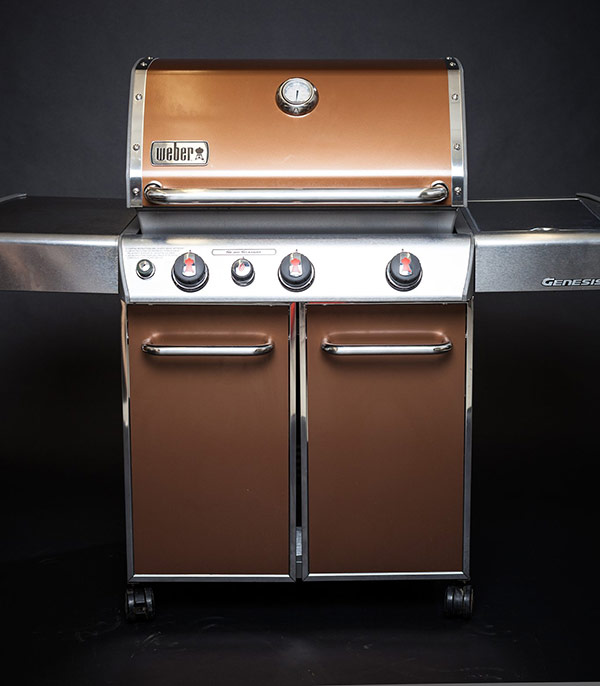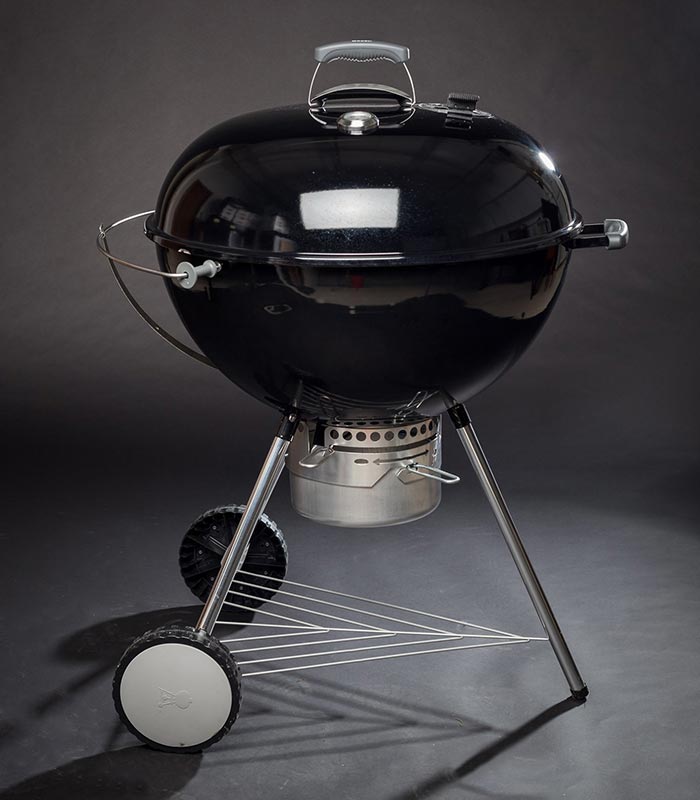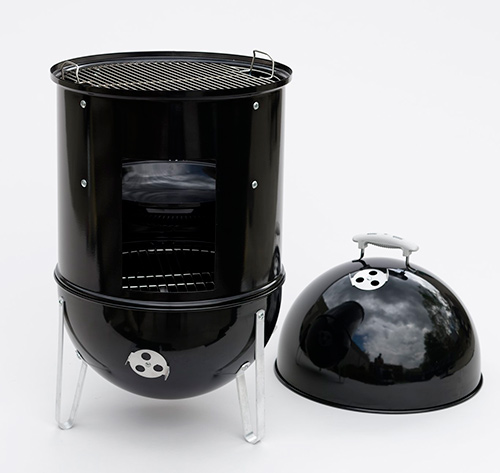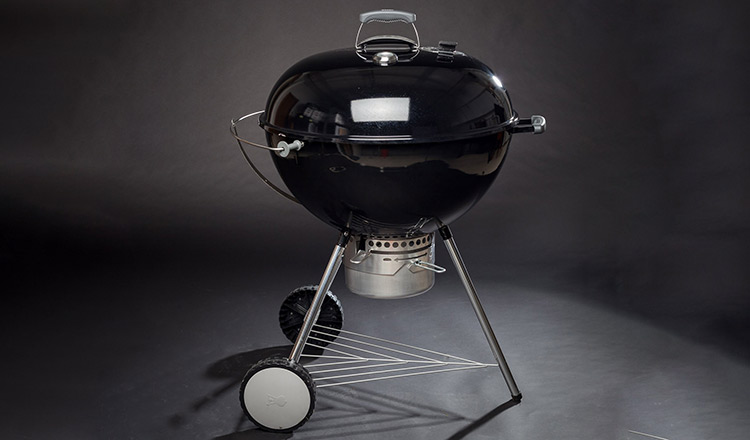Having the correct tools for the job certainly makes cooking easier, and that’s especially true when it comes to barbecuing and smoking. Think about your specific needs, and plan any equipment purchases accordingly. For example, if you don’t plan on making a lot of barbecue, you can get by with a basic gas or charcoal grill; it isn’t necessary to pay hundreds or thousands of dollars for a fancy smoker. Often what you are paying for with higher-priced or specialty pieces of equipment is convenience.
One critical tool, however, is a dual-probe thermometer. Maintaining proper temperatures is very important to all types of slow cooking, and a thermometer with two probes allows you to accurately monitor the temperature inside the cooker as well as the internal temperature of the food for a perfectly cooked product.
Grills
 A gas grill or charcoal grill works well for barbecuing, and most homes already have one. You can cook over either direct or indirect heat when using a grill, depending on where you concentrate the heat. Low- and slow-cooked foods are usually cooked over indirect heat: The fire and smoke are concentrated on one side of the grill and the food cooked on the other side.
A gas grill or charcoal grill works well for barbecuing, and most homes already have one. You can cook over either direct or indirect heat when using a grill, depending on where you concentrate the heat. Low- and slow-cooked foods are usually cooked over indirect heat: The fire and smoke are concentrated on one side of the grill and the food cooked on the other side.
On a charcoal grill, this is controlled by the placement of the coals. When using a charcoal grill, a few wood chunks can be placed on top of a few smoldering charcoal chunks to create flavorful smoke. Some gas grills come with a steel firebox that can hold some wood chips and be placed over a gas burner set on low.  With any type of grill, the lid is closed and left undisturbed for as long as possible to smoke and cook the food. A thermometer must be used to monitor the chamber temperature so that the heat can be increased or decreased as needed. The heat level is controlled by turning down the heat on a gas grill or by adjusting the vent holes on a charcoal grill.
With any type of grill, the lid is closed and left undisturbed for as long as possible to smoke and cook the food. A thermometer must be used to monitor the chamber temperature so that the heat can be increased or decreased as needed. The heat level is controlled by turning down the heat on a gas grill or by adjusting the vent holes on a charcoal grill.
Smokers and Barbecue Pits
For barbecuing, you need a chamber that will hold the food to be barbecued or smoked and contain the heat and smoke. A dedicated smoker can sometimes be preferable to a grill because it can maintain a more consistent temperature, allows for more airflow control than some grills, and contains a water pan to produce a high-humidity environment that won’t dry out the meat. Several kinds are available, and can be as high or low tech as your budget will allow. Some people even make their own smokers by placing a hot plate inside a covered container such as a new trash can or two large stacked planter pots.

Bullet smokers are tall, narrow units topped with a tight-fitting lid, so they look like a large bullet. These units have two racks inside that hold the product above a water pan, which is placed above the fire. A very popular bullet smoker for home use is the Weber Smokey Mountain smoker, or “WSM” as it is called in the barbecue world. It works very well for the home hot smoker or barbecue enthusiast because it is easy to use. It is composed of durable enameled steel, has a large door that allows you to add fuel and water without removing the lid, and doesn’t take up a lot of space.
Ceramic cookers are similar to bullet smokers in many ways, but made of ceramic material. This allows them to attain a much higher heat for grilling and to maintain the heat with a minimum amount of added fuel or smoking material. Less attention is needed with ceramic smokers because they maintain a nice, even heat for a long period of time. One popular ceramic cooker for home cooks is the Big Green Egg. The convenience and quality of the Big Green Egg does come with a hefty price tag, more than twice that of a WSM.
Electric smokers come in a wide variety of shapes, sizes, and prices. These units have a chamber that will hold several racks and space to hang food inside. They also have a water pan to keep the humidity level high. An adjustable electric element that produces heat allows for an even temperature, and there is also an internal or external smoke generator to produce the smoke for the chamber. Electric smokers have a heating element that will smolder wood sawdust, wood chips, or compressed sawdust briquettes that are produced by the manufacturer. This style of smoker can often be set up and let go for hours with little or no attention.
The sky’s the limit when it comes to barbecue pits or offset smokers. Barbecue pits are permanent structures that are built expressly for barbecuing meat in the backyard, while an offset smoker offers a bigger chamber than a bullet smoker to hold large quantities of meat. They both can range in cost from a few hundred to tens of thousands of dollars. Offset smokers are made of heavy-gauge cast iron or steel, which makes them very heavy and difficult to move. A special feature of these smokers is that they have a wood chamber that is separate from the cooking chamber. They can range from a backyard smoker purchased at a home improvement center to a smoker that is custom built on a trailer and pulled by an automobile or tractor trailer truck, although the latter is usually reserved for the very serious home cook or professional who will enter competitions or sell barbecue at events.
Thermometers
A thermometer is an essential piece of equipment when cooking meats. Monitoring the internal temperature of the meat with a thermometer allows you to perfectly cook the meat to a specific doneness, as in the case of prime rib, or to determine if the meat, such as a roast chicken, is fully cooked.
A basic dial probe thermometer with a nut on the back of the dial for adjusting calibration is a good choice. They are easy to read, durable, and water resistant and do not need batteries. They are excellent for checking meat temperatures when roasting, braising, or smoking.

A dual probe digital wireless thermometer is a perfect tool for barbecuing, when the temperature of the cooking chamber as well as the internal temperature of the meat should be closely monitored. It’s an ideal solution to have one probe inserted into the meat and the other inside the cooking chamber. This type of thermometer also allows you to check the temperature of the chamber and the meat from a distance without having to lift the cover of the cooking chamber.


